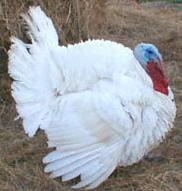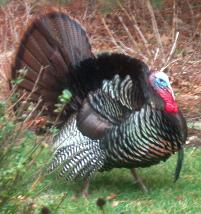
In 1990, the Oscar Mayer Louis Rich turkey processing plant in Tulare, California was in trouble. Their Kronos timeclocks were having serious data communications issues. They were not able to communicate reliably with the IBM PC computer used to poll them. The local service people had not been able to fix the problem. Kronos had then dispatched the head of its Service department all the way from our headquarters in Massachusetts, a distance of over 4,000 Km (2,500 miles). He had worked on the problem, but it persisted after his return. The Vice President Research & Development is not normally sent out on service calls, and that was my title at the time (and actually, through most of my nearly 25 years at Kronos). But I was also known as an excellent troubleshooter and problem solver, and the problem had escalated to the point where Kronos needed to bring in their "big guns". That meant me. The Oscar Mayer Louis Rich turkey processing plant was a fascinating place. Live turkeys went in one end of the huge building, and cold cuts came out the other. My cousin Lisa, who lives in California, had a vacation house in the area, and often drove by the plant. It was Lisa who dubbed it "The house of turkey death". Turkeys arrived at the plant from turkey farms all around the region, shipped in crates with slatted sides, stacked on long flat-bed trucks. The crates covered the flat bed of the truck from front to back and side to side, perhaps six to eight crates high. This meant that the crates in the center of the stack were quite far from the outside air. I was told that once a truck was loaded, it had to keep moving, so that air blew through the outer crates to reach those in the center. If something caused a truck to have to stop for any length of time in the hot California sun, the turkeys in the center crates would overheat and suffocate. Trucks were quickly unloaded when they arrived at the plant. If several trucks arrived together, all but one went to a holding area near the unloading zone, where huge fans blew air through the stack of crates (from side to side). This kept the turkeys in the center aerated even though the truck was no longer moving. Thanksgiving may be a happy holiday for you, but it's pretty awful if you're a turkey. Hence the next couple of paragraphs of this entry get rather graphic, so if you don't want to spoil your appetite for Thanksgiving turkey, you might want to click here to skip them. The unloading operation was rather messy, so workers donned protective jumpsuits, and wore respirators to protect their lungs from the clouds of dust and turkey fecal matter raised by the operation. Crates were pulled from the truck and opened, and each turkey was hung upside-down by its feet from a specially designed conveyor system. This didn't seem to upset the turkeys, who looked around curiously from their inverted position as the conveyor slowly moved them into the building. Of course, they didn't know what was coming next. Watching this operation as a truck pulled up for unloading, I noticed a man wearing a leather apron using a long leather strop to sharpen what looked like a straight razor. I didn't ask him for his job title. "Professional turkey killer"? "Expert throat-slitter"? What did it say on his résumé? Once the unloading started, as each turkey passed by him, he indeed slit its throat. I think the turkey might have been stunned first with an electrical shock; I do recall that it was also electrically jolted after its throat was slit, to cause its muscles to contract and expel most of its blood. I think this process had to do with the final product getting a Kosher certification, which requires most of the blood to be removed. The line then proceeded on to de-feathering, gutting, washing, and butchering. The plant had two distinct sides, separated by the large roasting oven. The input side of the oven was potentially contaminated, so workers from that side never crossed over to the sterile output side where the cooked turkeys emerged. All areas of the plant were washed down with steam and boiling water each evening. Our timeclocks were inside sealed boxes, whose doors could be closed before the washing was performed. At this plant, workers didn't punch in to their jobs until they reached their work stations, so our timeclocks were scattered all over the plant. Our data communications backbone was about three thousand feet long, so every thousand feet the signal was re-driven by a Kronos device called a "repeater", which I had in fact originally designed. But when I made a measurement at the central computer, the signals from the farthest timeclocks looked horrible on my portable oscilloscope, so I could see why we were having communications problems. Yet looking at the schematic diagram of the installation that had been supplied to me, I couldn't see any reason why the signals should have been so degraded. I then did something that apparently nobody had done before me: I traced out the wiring to see how the system was actually connected. Did the wiring match the schematic? No, it didn't. There was a repeater a thousand feet down the line, driving the nearest timeclock, but the rest of the line tapped the INPUT to that repeater, not the OUTPUT as shown on the schematic. And that problem was repeated at the second repeater two thousand feet down the line. The interface board in the PC was, all by itself, driving three thousand feet of wire, and all but two of the remote timeclocks. It was so overloaded that it was a wonder that it worked at all. I moved two wires at each repeater, and the problem was solved. None of the previous service people who had been sent out there had noticed this problem, nor had the head of the Kronos Service department, a very smart and competent man (since this particular episode is a bit embarrassing, I won't name him here). It seems that, as usual, the installers had drawn the schematic diagram first, to show what they had intended to install, but then when they connected the wires, they had inadvertently connected each continuing line to the wrong side of its repeater. And then, all the service people had assumed that the schematic generated by the installers was accurate. As the old saying goes, "When you ASSUME, you make an ASS out of U and ME." Note 1
Alison, our neighbor across the street, is a wildlife rehabilitator licensed by the Commonwealth of Massachusetts. She mostly cares for injured birds, and at any given moment has several recuperating avians in residence. She also puts out bird feeders, including food on the ground for our local turkeys. In the Spring mating season, dozens of turkeys gather outside her door in what they seem to take to be a very popular turkey dating bar. The males spread their tails and strut their stuff, trying to attract as many females as possible.  The hens then disappear for a while, later re-surfacing with their chicks following along behind. It's not uncommon for a hen to be followed by six to eight small chicks. But although the mother never gets very far away, their number often dwindles down a bit as they are picked off by hawks, owls, and perhaps even coyotes or foxes. However, once the surviving chicks reach a larger size, for example the size seen above, they are seldom taken. I think they're too large for a raptor, and the larger predators are not as prevalent. Once the chicks start to appear, it's not uncommon to see groups of thirty or so turkeys stroll across our lawn in a ragged line. When we first moved out to Wayland in 1972, there were no turkeys in the area, although there were quite a few pheasants. We used to see them frequently, and even more often, hear their raucous calls (they make a screeching sound rather like a washing machine with a slipping belt). For some reason, the pheasants have now all died out. But as Boston.com reports, "... between 1979 and 1996, wildlife officials trapped more than 500 turkeys in the Berkshires and released them elsewhere in the state." Note 3 They've done very well. I rather like them, even though I have to stop my car from time to time as they parade up the center of our street. But don't get me started on the Canada Geese. I understand that the house of turkey death has now closed - score one for the turkeys. I hope you enjoy your Thanksgiving, and if the story above has made you a vegetarian, well, there's usually a lot of other stuff to eat.
  Note 1: I recall hearing a similar story from an MIT professor putting together a take-home electrical engineering lab kit for students. He assembled all the parts that went into it, which included an electrical multi-meter, and decided how to arrange them in a box. Using the specification sheet on the meter to get its exact dimensions, he put in an order for hundreds of boxes. And when they arrived, the contents didn't fit into the box. Tracking down what had gone wrong, the professor found that the spec sheet for the meter listed an incorrect dimension - it was actually an inch wider than the sheet said. An entirely new order had to be put in for larger boxes. The professor took this as a lesson. He had had a meter in front of him when laying out the box contents, but rather than measure it, he had simply believed the (incorrect) dimension shown on the spec sheet. [return to text] Note 2: See The Eagle, Ben Franklin, and the Turkey [return to text] Note 3: From Turkeys take to cities, towns, Boston.com. [return to text]  |
 Since this entry is being released on Thanksgiving, 2010, it will be about turkeys. I'll start with "The house of turkey death".
Since this entry is being released on Thanksgiving, 2010, it will be about turkeys. I'll start with "The house of turkey death".
